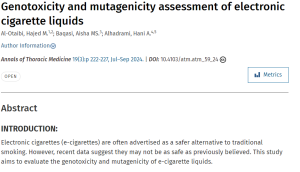Since the beginning of using tobacco in the form of the modern cigarette in the late 19th century, there have been warnings about the harmful effects of smoking on human health, particularly also regarding the sensitive cardiovascular system. In view of the serious consequences for health, the only reasonable solution would be to give up smoking completely and to prevent the young from starting to smoke. However, the addiction to nicotine is too powerful for most smokers; the same applies to the companies’ desire to make a profit. Therefore, both health professionals and companies have been working to develop a healthier alternative, the latest stage of which is the current electronic-cigarette (e-cigarette).1 Since the introduction of the e-cigarette in 2005 in Europe and the United States, various societies have been hoping for a reduction in the harmful effects of conventional cigarettes by switching to the use of e-cigarettes. However, are we on the right track?
According to the World Health Organization, the number of smokers decreased continuously, for example, by 1 million between 2018 and 2020 worldwide.2 This decline is encouraging. However, is this reduction due to the introduction and promotion of e-cigarettes? A detailed analysis of the figures says no because the marketing of e-cigarettes as the healthier alternative has prompted some people to start vaping. In addition, it is precisely these people who later switch to smoking conventional cigarettes due to e-cigarette–induced nicotine addiction or even both as dual users.3 Beyond that, young people in particular started using e-cigarettes because the big tobacco companies managed to portray e-cigarettes as cool by using different social media platforms. The popularity of e-cigarettes and electronic nicotine devices among young people was massively increased by the introduction of tasty, teenager-friendly flavors. So the number of e-cigarette users is raising continuously and exponentially (e-cigarettes being the most common used smoking product in 2014 in the United States), in particular, among the middle- and high-school students.4
What will we know about e-cigarette use in the future? Long-term studies will reveal the effects of e-cigarette use on human health, for example, the prevalence of atherosclerosis and cardiovascular diseases.
In our opinion, it is much too early to categorize the hazards of e-cigarette use. It took 60 years to assess the hazards of conventional cigarette use.5 Clearly, research today is faster and more sophisticated than research in the past (eg, by the usage of artificial intelligence, novel imaging tools, improved animal models), but we can still expect it to be decades before we can define the hazards of e-cigarettes.
E-CIGARETTES AND ENDOTHELIAL DYSFUNCTION
An analysis of the literature using the key words e-cigarette and endothelial cells resulted in 64 publications in PubMed to date (excluding reviews). For comparison, the key words cigarette smoking and endothelial cells yielded 500 results (excluding reviews). This difference in the numbers alone makes it clear that there is a significant gap with regard to the effect of e-cigarette aerosols on endothelial cells. To summarize, companies are telling people that e-cigarette use is less harmful to endothelial cells than conventional cigarettes, although the current number of studies does not justify such claims.
In 2016, we were one of the first to report on the cytotoxic effects of e-cigarette liquids on endothelial cells in vitro.6 Further in vitro studies confirmed our results on e-cigarette liquid cytotoxicity7 and e-cigarette–induced endothelial dysfunction.8 Further in vitro studies revealed e-cigarette liquid–induced oxidative stress and DNA damage7 and impaired angiogenesis.9
Aside from in vitro cell culture studies, also in vivo animal studies were conducted. In an acute setting, Rao et al10 exposed rats to aerosol of 3 different e-cigarette types (as well as different flavors and with or without nicotine), and the authors concluded that the range of tested e-cigarette aerosols impaired flow-mediated dilatation (FMD) comparable to conventional cigarettes after single use.10 Chronic exposure of e-cigarette aerosol to mice resulted in accelerated aortic arterial stiffness and impaired aortic endothelial function, and it is assumed that this is followed by an impairment of heart function.11 Particularly noteworthy is the study by Jin et al,12 which shows that e-cigarette aerosols based on propylene glycol and vegetable glycerin contain pulmonary irritants that can cause endothelial dysfunction and thus increase the risk of cardiopulmonary diseases. Moreover, the authors found out that formaldehyde, the concentration of which in e-cigarettes is not regulated, perhaps contributes to the adverse cardiopulmonary effects in mice.12
Aside from in vitro and animal studies, different in vivo studies were conducted. Already in 2016, Carnevale et al13 demonstrated that smoking only 1 cigarette (0.6-mg nicotine) is associated with an increase in oxidative stress markers, endothelial dysfunction, and a decrease in the amount of blood vitamin E. The same study participants 1 week later vaped a tobacco flavored e-cigarette (9 puffs to reach the same nicotine concentration as for the conventional cigarettes). Just like the conventional cigarette, vaping the e-cigarette increased circulating oxidative stress markers and reduced the FMD whereby the authors emphasize that e-cigarettes have a lesser impact in this acute model. In addition, the mentioned effects were present in previous smokers and nonsmokers.13 In contrast, Haptonstall et al14 did not record an impaired FMD in participants vaping an e-cigarette. The authors explained the different results by the fact that in the study by Carnevale et al,13 chronic conventional cigarette smokers used an e-cigarette, whereas in the study by Haptonstall et al,14 chronic e-cigarette vapers used e-cigarettes and that the vascular reserve in tobacco users is lower. By combining a human and an animal study, Kuntic et al15 demonstrated that e-cigarette aerosol induces vascular, cerebral, and pulmonary oxidative stress, inflammation, and an increase in blood pressure in exposed mice. In human vapers, they detected a reduced FMD. Interestingly, they identified the toxic aldehyde acrolein as one of the key mediators of the mentioned effects.15 Worth mentioning is also the study by Biondi-Zoccai et al16 in which they compared the effects of heat-not-burn cigarettes, e-cigarettes, and conventional tobacco cigarettes. In fact, they showed acute adverse cardiovascular effects (among others, systemic oxidative stress, impaired FMD) that were induced by all 3 cigarette types, but the effects were less pronounced with heat-not-burn cigarettes.16 Analyzing the effects on heart rate and hemodynamics revealed that chronic use of both e-cigarettes and conventional cigarettes exerted a similar resting heart rate variability. Acute effects on hemodynamics were greater in conventional cigarette smokers.17
Antoniewicz et al18 revealed that e-cigarette use increases the amount of endothelial progenitor cells and endothelial E-selectin positive microvesicles in the blood of healthy volunteers. This observation was interpreted by the authors as potentially harmful as the effects of repeated recruitment of endothelial progenitor cells are unknown. Further, 3 important and recent human studies are worth mentioning. In 2020, Fetterman et al19 reported results from a human study, showing that people who only use e-cigarettes had a similar vascular profile compared with users of conventional cigarettes in the means of changed vascular stiffness and reduced NO production of endothelial cells after stimulation.19 Later, in 2022, Mohammadi et al20 performed a human study analyzing chronic smokers/vapers and published that vaping/e-cigarette use and smoking conventional cigarettes impairs FMD. The authors showed that incubation of cultured endothelial cells with serum of e-cigarette users resulted in an increase in endothelial permeability compared with nonuser serum. Moreover, they demonstrated that e-cigarette users showed an increase in some risk biomarkers that were not elevated in smokers and that smokers showed an increase in other risk biomarkers that were not elevated in e-cigarette users.20 This study suggests that the adverse effects on endothelial cells induced by e-cigarette use are comparable to those induced by using conventional cigarettes and even important is the fact that e-cigarettes are inducing different harmful cardiovascular alterations in endothelial cells. This illustrates how important such human studies are, particularly in a long-term setting. However, with regard to the study by Mohammadi et al,20 it should be noted that the time of use of e-cigarettes and conventional cigarettes varies greatly (1.7 versus 10.2 years). Therefore, it cannot be ruled out that the effects of e-cigarettes are even stronger with the same duration of use. In connection with long-term effects, we should focus on studies that examine the decades-long use of e-cigarettes, since atherosclerosis and cardiovascular diseases do not develop within a few years.
Recently in August 2023, Lyytinen et al21 published that e-cigarette vaping induced thrombogenicity and impaired microvascular function in healthy study participants. In detail, the authors used an acute exposure model (30 puffs), and after drawing blood, they used a total-thrombus-formation analysis system to analyze fibrin-rich thrombus and platelet thrombus formation in whole blood and under flow conditions. Additionally, the study analyzed microvascular function by laser speckle contrast imaging and iontophoresis of acetylcholine and sodium nitroprusside. The authors further concluded that both fibrin- and platelet-dependent thrombus formation and reduced microvascular dilatation capacity are dependent on the presence of nicotine in e-cigarette aerosols.21 Considering that these authors used an acute exposure model and the fact that nicotine makes the difference in their effects, it is possible that nicotine-containing e-cigarettes have further, previously unknown and more adverse endothelial effects than expected.
However, there are important aspects to consider with regard to the results of e-cigarette aerosols on endothelial cells or the vascular system. First, in the case of e-cigarettes, less harmful does not mean that there are no hazardous effects when using them. Interestingly, the analysis of the literature showed that studies that did not include a tobacco cigarette comparison group tended to present the effects of e-cigarettes more dramatically than those including the comparison group. It would be desirable for the society if long-term studies would prove that e-cigarettes are less harmful. Clearly, no data supporting this assumption exist at present and predictions about the long-term effects of e-cigarette use are misleading and dangerous. Second, the results regarding the adverse effects of smoking conventional cigarettes are based on decades of research; the e-cigarette is a young (maximum 18 years) and still changing product and research into its effects is even more recent. Third, e-cigarettes are composed of different technologies and chemicals, including flavors (in different amounts and intensities). Therefore, a comparison of results/studies is difficult as different compositions can bring up different results. Fourth, and most importantly, long-term studies are practically nonexistent at present. Fifth, the study by Mohammadi et al20 suggests that we are focusing too much on analyzing whether e-cigarette aerosols cause similar endothelial alterations as smoking conventional cigarettes. Is it possible that we are forgetting to investigate the effects that are not already known from conventional cigarettes?
One of the biggest uncertainties is the impact of e-cigarette second/third hand aerosols on health. PubMed-based searching for the key words e-cigarette, second-hand aerosols, and endothelial cells yielded not a single result. Clearly, also studies on the effects of second-hand tobacco consumption are rare.
Conclusions
After summarizing the published data, we conclude that e-cigarettes have failed to achieve their initial goals—both from a scientific and a health care perspective. Realistically, tobacco/e-cigarette companies have fully achieved their goals.
Although the number of tobacco smokers declined, the number of e-cigarette users has exploded. So many people changed their nicotine delivery devices and so many more became addicted. At the end, we have 1 winner, the tobacco/e-cigarette companies, and millions of losers, the addicted. There will be even more e-cigarette users in the coming years, as they believe they are consuming the healthier alternative.
Based on the current data, it seems that e-cigarette aerosols may be less harmful to the vascular endothelium than conventional tobacco smoke. This questionable hypothesis is based on a small number of scientific studies, and long-term results in the field of cardiovascular research are essentially absent. Looking at the latest data, it is obvious that this opinion is changing. The latest and most recent studies suggest that we have underestimated the effects of e-cigarette aerosols, as smoke-atypical effects have also been discovered, such as altered microvascular functions. Data that allow a realistic view of the cardiovascular effects of e-cigarette aerosols are, therefore, yet to be published.
At the end, the authors would like to call on all scientists to advance the scientific output regarding the effects of e-cigarettes on the human body and in particular on the cardiovascular system. Only based on a significant number of valid studies and the generation of hard facts produces a scientific basis that provides precise and clear information for smokers, vapers, and quitters. This basis should allow people, and particularly the young, to receive proper and scientifically valid information, actively, to help them refrain from nicotine and to not become a patient of the current pandemic.
Source: AHA Journals










